English
Castellano
Català
Some NJ Fluorescent Minerals
Author: Stuart Schneider
Content by courtesy of : Fluorescent minerals
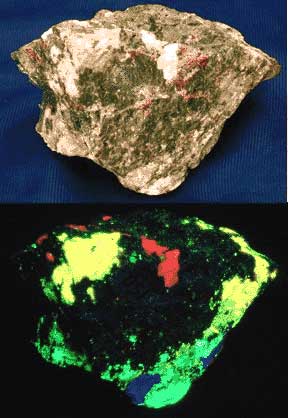
These pages show fluorescent minerals from our collection. Living in New Jersey, we chose to concentrate on fluorescents from our state. Most come from the Franklin and Sterling Hill Mines. As the collection grew, we realized that there were many beautiful and unusual fluorescent minerals from other places that deserved a space on the shelves of our display room so, we have included other states, Canada, Mexico, Greenland and hopefully others.
Throughout these pages, the first photo shows the mineral under regular light while the second photo shows the mineral under short wave (SW) ultraviolet (UV) light and/or long wave (LW) UV light. There are links to other fluorescent sites, an explanation of terms, history, books on the subject, suggestions for lights and such.
The piece above is a four color beauty. The green is Willemite, the red is Calcite, the blue is Hardystonite and the yellow is Espirite. The non-fluorescing (NF) black is Franklinite and the NF red is Zincite. Hardystonite and Espirite were only found in the Parker Shaft of the Franklin Zinc Mine in Sussex County, New Jersey. This mine closed in 1954 and the Parker and other shafts flooded and caved in. No more of these rare minerals are coming out of the mine. Sterling Hill Mine closed in 1986 and is also flooded.
By the way, the black light that is widely sold in party stores and Spencer Gifts and that lights up fluorescent paints and posters so nicely, will not bring out the colors in these stones. You must use a special filtered SW Ultraviolet light to obtain this effect. These are sold as mineral lights and are available in short wave, middle wave, and long wave frequencies. Sometimes they are labeled as UV-C, UV-B, and UV-A, respectively. The links section will list several sources for lights. Mineral lights cost anywhere from $30.00 to $400 or more. The cost difference is in the power of the light. The lower end UV lights are 4 watt lights and the higher end are 15 watt lights. The biggest cost is the short wave filters which are only made by one company in the world. These are expensive pieces of coated glass that must be made to pass only the proper frequencies (waves) of light. We have several different lights. If you can afford it, buy a powerful light. A word of warning, Short Wave UV light can cause sunburn and burn the eyes. Fluorescent collectors know that you aim the light away from your face and when you must use the light for extended periods of time, wear protective eye shields or glasses that block UV rays.
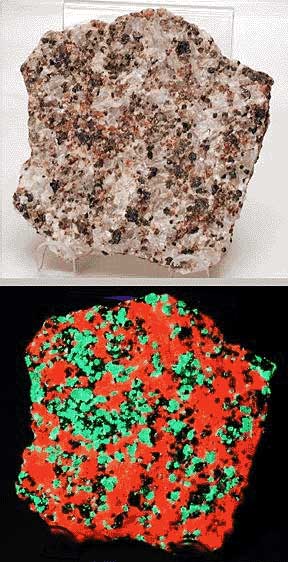
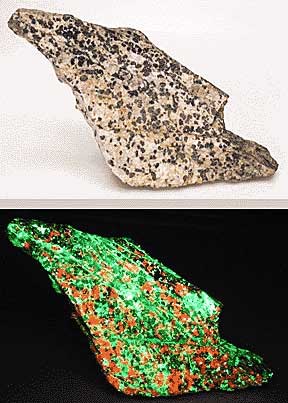
The most easily recognized stones from the Franklin Zinc Mine and the nearby Sterling Hill Zinc Mine are sometimes referred to as Christmas Calcites or Crazy Calcites. The two stones above are Calcite (fluorescent Red SW) and Willemite (fluorescent Green SW). The black pieces are NF Franklinite and the reddish bits are NF Zincite or sometimes Andradite Garnet. The Calcites and Willemites from these mines situated at the northwest corner of New Jersey, glow with a color that is not found anywhere else. This area of New Jersey has more varieties of minerals (about 400) than anywhere in the world. Mineral collectors make pilgrimages to these sites. The area also is the source of about 85 fluorescent minerals. On the last page of the fluorescent section are links to the Franklin Zinc Mine and the Sterling Zinc Mine that are now run as museums.
As an aside, one of the funniest things you can see at a rock and mineral show or outside these two museums (on special days) are the people who carry their mineral lights and a blanket. When they check out a rock, they cover their heads with the blanket and shine the light on the material in the darkened space. So if you ever see people crouching under a blanket at a rock show, check it out and see what kind of fluorescents they are looking at.
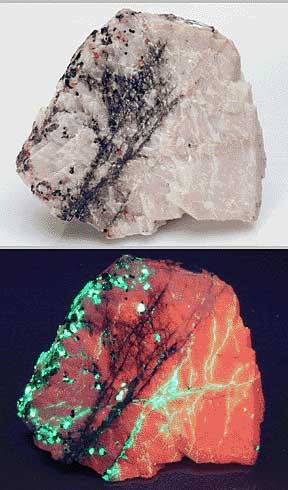
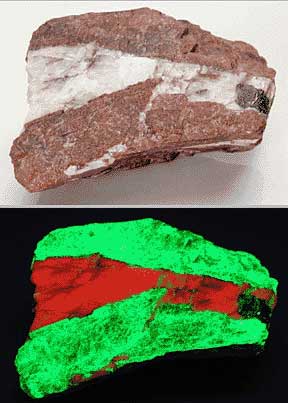
The better pieces have interesting variations on the Willemite and Calcite arrangement. For example, the piece on the left above has veins of Franklinite, specks and veins of Willemite (green) criss crossing the Calcite (red/orange). The piece on the right above has a large vein of Calcite dividing brown Willemite. Willemite can be found in many daylight colors such as brown, black, or white. Some people call the brown Willemite "Troosite". Once the SW light hits them, the Willemite green makes its presence known.
It is interesting that Calcite can be found that glows various shades of red or sometimes it does not fluoresce at all. One rock may have both fluorescent and NF varieties of Calcite in it. There are subtle color variations in some of these minerals that allows experts to identify a stone as being from Franklin rather than from Sterling Hill and vice versa. The mines are only 2.5 miles apart. The fluorescence in most of the Franklin and Sterling Hill rocks is caused by minute amounts of other minerals called "activators". Sometimes the activator is Lead, Uranium, or most often in the New Jersey rocks, the activator is Manganese. There are other activators mentioned in the books. None of the stones shown here gain their fluorescence from Uranium and none of them are radioactive. There are also "quenchers" of fluorescence. If they are present in often the tiniest amount, the rock will not fluoresce. Iron is a known quencher, however a few rocks that contain iron do fluoresce.
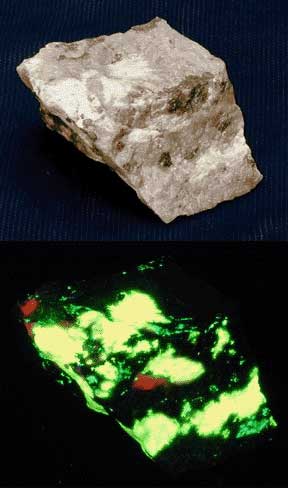
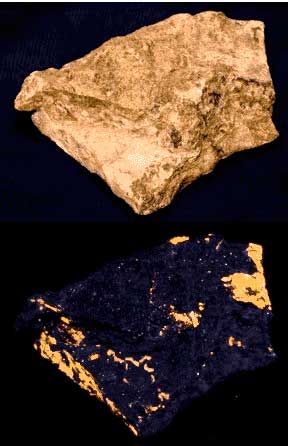
Above left is a wonderful piece of Espirite (Yellow SW) with Calcite (Red SW). On the right is a stone containing Clinohedrite (Orange SW). Clinohedrite is a complex mineral containing Hydrogen, Calcium, Zinc, Silicon, and Oxygen. Clinohedrite apparently entered the cracks in the mine as a watery solution and is found as thin layers or coatings on another rock. Fluorescent Clinohedrite comes from the Parker Shaft of the Franklin Mine.
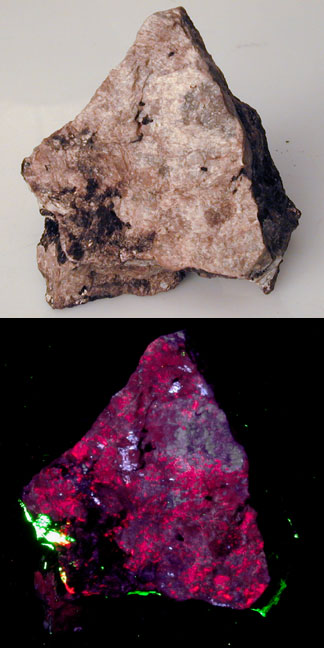
Above is a rare mineral from the Parker Shaft of the Franklin Mine. It is Manganaxinite with Margarosanite, Xonolite, and a touch of Willemite and Calcite, from Franklin, NJ. Manganaxinite glows cherry red (SW), the spots of Margarosanite glows sky blue and the Xonolite glows purple. The Willemite glows green (SW) and the touch of Calcite at the bottom left glows orange.
Content by courtesy of :
There you'll find more very interesting NJ and Foreign Fluorescents pages, and also fluorescent books and links.
Information | Mineral photos | VIDEOS | Articles | Fairs | Web directory | Classified ads | Minerals Books | Shop

